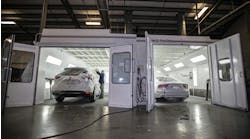In severe winter areas, many motorists opt for a seasonal changeover that employs true winter tires to combat the expected ice and snow.
Goodyear’s Ultra Grip line of winter tires, according to brand manager Silvana Valencic, is engineered to perform in cold temperatures as well as in snow and slush.
“The bottom line for consumers is knowing what level of winter they might face,” says Valencic.
“Based on past experiences, do they feel their winter weather is moderate enough to choose a year-round tire? Or do they face sometimes severe winter weather, and they prefer the peace of mind offered by true winter tires?”
The company is now offering its new Ultra Grip IceWRT winter tire with tread designs for both SUVs and light trucks.
Whatever tire is chosen, Valencic provides some advice for motorists who will be faced with potential slippery driving conditions this winter:
- Match your driving speed to the current conditions.
If conditions are challenging due to a slippery road surface
or reduced visibility, decrease your speed. A slower driving
speed allows more time for a necessary response.
- Additional factors to consider when adjusting speed
are the condition of the vehicle, its tires and your driving
abilities. Always keep in mind the posted speed limits, and
understand that those limits indicate the maximum speed when
weather conditions are good.
- Plan ahead and try to anticipate potentially
dangerous situations. When approaching a curve or
potentially slick area of the road, use the brakes
effectively. The brakes should be applied only before a
curve and on a straight section of the road. Sometimes,
taking your foot off the accelerator and allowing the
vehicle to naturally slow without using the brakes is best.
- Be alert to other vehicles. Maintain enough distance
between your vehicle and the one ahead of you. If someone
else seems to be following too close to your vehicle,
perhaps slow down to allow them to pass – rather than
speeding up to achieve a distance between vehicles.
- If visibility is poor, remember to use your lights.
This helps other drivers to see you when approaching or when
following. You should always turn your lights on when your
windshield wipers are on.
- Set the vehicle cabin to a comfortable temperature.
This can be a challenge during winter when drivers and
passengers may be wearing heavy coats in a vehicle, but it
is imperative to be comfortable when driving. Cabin comfort
includes keeping the windows free of frost, ice and snow.
- Be as smooth as possible, avoiding sudden braking
and steering responses. Always signal early when turning or
stopping, in order to alert approaching or following
drivers.
- Avoid overconfident driving, and avoid
overestimating the vehicle’s capability simply because it is
equipped with anti-lock brakes, four-wheel drive, traction
control, winter tires or other safety devices. Do not allow
good judgment and smart driving to be overtaken by a false
sense of security provided by vehicle technology.
- Before driving in inclement weather, be sure that your vehicle is properly maintained. Make sure your windshield wipers work properly; have the correct level of antifreeze for heating and defrosting the vehicle; keep plenty of gas in the tank; and always use required safety devices such as seatbelts.
For more information visit www.goodyeartires.com.


